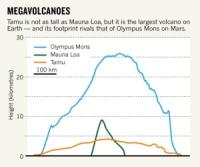 Scientists have identified the largest volcano on earth, beneath the Pacific Ocean roughly half way between Japan and the Hawaiian Islands. The giant shield volcano has been named Tamu Massif and it is roughly, 100,000 square miles or approximately the size of the British Isles or New mexico. Mauna Loa, on the island of Hawaii, now the second largest volcano on earth covers, by comparison, 2,000 square miles.
Scientists have identified the largest volcano on earth, beneath the Pacific Ocean roughly half way between Japan and the Hawaiian Islands. The giant shield volcano has been named Tamu Massif and it is roughly, 100,000 square miles or approximately the size of the British Isles or New mexico. Mauna Loa, on the island of Hawaii, now the second largest volcano on earth covers, by comparison, 2,000 square miles.
Underwater volcano is Earth’s biggest
<The megavolcano has been inactive for some 140 million years. But its very existence will help geophysicists to set limits on how much magma can be stored in Earth’s crust and pour out onto the surface. It also shows that Earth can produce volcanoes on par with Olympus Mons on Mars, which, at 625 kilometres across, was until now the biggest volcano known in the Solar System.
“This says that here on Earth we have analogous volcanoes to the big ones we find on Mars,” says William Sager, a marine geologist at the University of Houston in Texas. “I’m not sure anybody would have guessed that.” Sager and his colleagues describe the structure, named Tamu Massif, in Nature Geoscience on 8 September. ‘Tamu’ is an acronym for Texas A&M University in College Station, where Sager was formerly employed….
Sager and his colleagues were startled by findings they made after sailing the research vessel Marcus G. Langseth over Tamu in 2010 and 2012. They used air guns to send seismic waves through the mountain, and monitored the reflections. The seismic waves penetrated several kilometres into the massif — and showed that all of its lava flows dipped away from the volcano’s summit, implying a central magma vent. “From whatever angle you look at it, the lava flows appear to come from the centre of this thing,” says Sager.
Over time, the lava coursed downhill and then solidified, building up a volcano with a long, low profile similar to that of a shield laid on the ground. The world’s biggest active shield volcano, Mauna Loa on Hawaii, has an areal footprint just 15% of Tamu’s — but Mauna Loa is taller, rising 9 kilometres from sea floor to summit.
Thanks to Irwin Bryan for contributing to this post.
